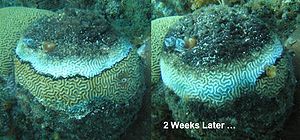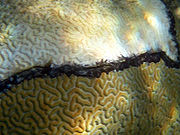
Black band disease
Encyclopedia

Coral
Corals are marine animals in class Anthozoa of phylum Cnidaria typically living in compact colonies of many identical individual "polyps". The group includes the important reef builders that inhabit tropical oceans and secrete calcium carbonate to form a hard skeleton.A coral "head" is a colony of...
tissue degradation due to a pathogenic microbial consortium
Microbial consortium
A microbial consortium is two or more microbial groups living symbiotically....
that appears as a dark red or black migrating microbial mat. The mat is present between apparently healthy coral tissue and freshly exposed coral skeleton.
Appearance

Phycoerythrin
Phycoerythrin is a red protein from the light-harvesting phycobiliprotein family, present in cyanobacteria, red algae and cryptomonads.Like all phycobiliproteins, phycoerythrin is composed of a protein part, organised in a hexameric structure of alpha and beta chains, covalently binding...
) is dependent on the thickness of the band. The band is approximately 1 mm thick and ranges in width from 1 mm to 7 cm. White specks may be present on surface, at times forming dense white patches. The pathogenic microbial mat
Microbial mat
A microbial mat is a multi-layered sheet of micro-organisms, mainly bacteria and archaea. Microbial mats grow at interfaces between different types of material, mostly on submerged or moist surfaces but a few survive in deserts. They colonize environments ranging in temperature from –40°C to +120°C...
consortium moves across coral colonies at rates from 3 mm to 1 cm/day. Tissue death is caused by exposure to an anoxic
Hypoxia (medical)
Hypoxia, or hypoxiation, is a pathological condition in which the body as a whole or a region of the body is deprived of adequate oxygen supply. Variations in arterial oxygen concentrations can be part of the normal physiology, for example, during strenuous physical exercise...
, sulfide-rich microenvironment associated with the base of the band.
Composition
The black band microbial consortium consists of an assortment of photosyntheticPhotosynthesis
Photosynthesis is a chemical process that converts carbon dioxide into organic compounds, especially sugars, using the energy from sunlight. Photosynthesis occurs in plants, algae, and many species of bacteria, but not in archaea. Photosynthetic organisms are called photoautotrophs, since they can...
and non-photosynthetic bacteria
Bacteria
Bacteria are a large domain of prokaryotic microorganisms. Typically a few micrometres in length, bacteria have a wide range of shapes, ranging from spheres to rods and spirals...
that co-exist synergistically
Synergy
Synergy may be defined as two or more things functioning together to produce a result not independently obtainable.The term synergy comes from the Greek word from , , meaning "working together".-Definitions and usages:...
. The consortium has three functionally and physically dominant members as well as numerous heterotroph
Heterotroph
A heterotroph is an organism that cannot fix carbon and uses organic carbon for growth. This contrasts with autotrophs, such as plants and algae, which can use energy from sunlight or inorganic compounds to produce organic compounds such as carbohydrates, fats, and proteins from inorganic carbon...
ic members whose role in the disease is as yet unknown. The four functionally dominant members are populations of cyanobacteria and sulfide-oxidizing and sulfate-reducing bacteria
Sulfate-reducing bacteria
Sulfate-reducing bacteria are those bacteria and archaea that can obtain energy by oxidizing organic compounds or molecular hydrogen while reducing sulfate to hydrogen sulfide...
. The black band disease microbial consortium is structurally and functionally identical to cyanobacterial-dominated microbial mats found in other illuminated, sulfide-rich environments.
Taxonomy
Several species of cyanobacteria have been found associated with black band disease (Frias-Lopez et al.,2002; Cooney et al., 2002), the most well-known of which is Phormidium corallyticum. Sulfide-oxidizing bacteria, dominated by BeggiatoaBeggiatoa
Beggiatoa is a genus of bacteria in the order Thiotrichales. They are named after the Italian medic and botanist F.S. Beggiato. The organisms live in sulfur-rich environments...
spp. (Ducklow and Mitchell, 1979) , are presentg in well-developed bands and exhibit visible vertical migrations within the band matrix (Richardson, 1996; Viehman and Richardson, 2006). When present on the band surface Beggiatoa appears white due to intracellular inclusions of stored elemental sulfur
Sulfur
Sulfur or sulphur is the chemical element with atomic number 16. In the periodic table it is represented by the symbol S. It is an abundant, multivalent non-metal. Under normal conditions, sulfur atoms form cyclic octatomic molecules with chemical formula S8. Elemental sulfur is a bright yellow...
. Sulfate-reducing bacteria dominated by Desulfovibrio
Desulfovibrio
Desulfovibrio is a genus of Gram negative sulfate-reducing bacteria. Some species of Desulfovibrio are capable of transduction. Desulfovibrio species are commonly found in aquatic environments with high levels of organic material, as well as in water-logged soils, and form major community members...
spp. (Ducklow and Mitchell, 1979; Frias-Lopez et al.,2002; Cooney et al., 2002) are present at the base of the band and are responsible for producing high concentrations of sulfide within the band matrix (Carlton and Richardson, 1995). Light microscopic
Microscope
A microscope is an instrument used to see objects that are too small for the naked eye. The science of investigating small objects using such an instrument is called microscopy...
observation of black band reveals motile (gliding) filaments of P. corallyticum that are 4 mm wide, with one round end and one narrow (sharply tapering) end. Also present are gliding Beggiatoa filaments (1-4 mm wide) that are non-pigmented but contain highly refractive intracellular granules of elemental sulfur. Numerous gram-negative
Gram-negative
Gram-negative bacteria are bacteria that do not retain crystal violet dye in the Gram staining protocol. In a Gram stain test, a counterstain is added after the crystal violet, coloring all Gram-negative bacteria with a red or pink color...
bacteria (small rods) are also present but not identifiable using light microscopy. The bacterial population has been characterized using molecular techniques and was found to contain over 500 species of bacteria that are different from bacterial communities found in the water column, healthy coral tissue, or dead coral skeleton (Frias-Lopez et al., 2002; Cooney et al., 2002). The functional role of this diverse population of bacteria is not known.
Black band disease affects 42 species of coral in a worldwide distribution. The only known reservoir is within cyanobacterial biofilm
Biofilm
A biofilm is an aggregate of microorganisms in which cells adhere to each other on a surface. These adherent cells are frequently embedded within a self-produced matrix of extracellular polymeric substance...
s that are present on sediments in depressions of healthy black band disease susceptible corals.
See also
- White band diseaseWhite band diseaseWhite band disease is characterized by complete coral tissue degradation of Caribbean acroporid corals. Two species are affected, Acropora palmata and A. cervicornis . The disease exhibits a sharp demarcation between apparently healthy coral tissue and exposed coral skeleton...
The cause of this disease remains unknown. - Brown band disease AKA Red band disease, probably caused by ciliateCiliateThe ciliates are a group of protozoans characterized by the presence of hair-like organelles called cilia, which are identical in structure to flagella but typically shorter and present in much larger numbers with a different undulating pattern than flagella...
s (possibly Helicostoma nonatum) and cyanobacteria - Yellow-band diseaseYellow-band diseaseYellow-band disease is a disease that attacks colonies of coral at a time when coral is already under stress from pollution, overfishing, and climate change...
AKA Yellow blotch disease - Skeletal Eroding BandSkeletal Eroding BandSkeletal eroding band is a disease of corals that appears a black or dark gray band that slowly advances over corals, leaving a spotted region of dead coral in its wake...
, caused by the ciliate Halofolliculina corallasiaHalofolliculina corallasiaHalofolliculina corallasia is a heterotrich ciliate identified as a cause of the syndrome called Skeletal Eroding Band . It is the first coral disease pathogen that is a protozoan as well as the first known to be an eucaryote; all others identified are bacteria... - White plague, caused by the bacterium Aurantimonas coralicida
- Black necrosing syndrome AKA Dark spots disease, probably caused by a fungusFungusA fungus is a member of a large group of eukaryotic organisms that includes microorganisms such as yeasts and molds , as well as the more familiar mushrooms. These organisms are classified as a kingdom, Fungi, which is separate from plants, animals, and bacteria...
- Rapid Wasting, possibly caused by a fungus growing on areas damaged by feeding action of the parrotfishParrotfishParrotfishes are a group of fishes that traditionally had been considered a family , but now often are considered a subfamily of the wrasses. They are found in relatively shallow tropical and subtropical oceans throughout the world, but with the largest species richness in the Indo-Pacific...
Sparisoma viride - White pox diseaseWhite pox diseaseWhite pox disease , first noted in 1996 on coral reefs near the Florida keys, is a coral disease affecting Elkhorn coral throughout the Caribbean. It causes irregular white patches or blotches on the coral that result from the loss of coral tissue...
, caused by the bacterium Serratia marcescensSerratia marcescensSerratia marcescens is a species of Gram-negative, rod-shaped bacterium in the family Enterobacteriaceae. A human pathogen, S. marcescens is involved in nosocomial infections, particularly catheter-associated bacteremia, urinary tract infections and wound infections, and is responsible for 1.4% of... - AspergillosisAspergillosisAspergillosis is the name given to a wide variety of diseases caused by fungi of the genus Aspergillus. The most common forms are allergic bronchopulmonary aspergillosis, pulmonary aspergilloma and invasive aspergillosis. Most humans inhale Aspergillus spores every day...
, caused by the fungus Aspergillus sydowii, affects Gorgonian soft corals commonly known as sea fans.

